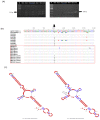Molecular Analysis and Ex Vivo Infectivity of Seronegative Occult Hepatitis C Virus: A Study in Single Haemodialysis Centre
- PMID: 38694575
- PMCID: PMC11057825
- DOI: 10.21315/mjms2024.31.2.4
Molecular Analysis and Ex Vivo Infectivity of Seronegative Occult Hepatitis C Virus: A Study in Single Haemodialysis Centre
Abstract
Background: In occult hepatitis C virus infection (OCI), hepatitis C virus ribonucleic acid (HCV RNA) is detectable in peripheral blood mononuclear cells (PBMCs) but is not evident in serum or plasma. Understanding of OCI in patients with seronegative anti-HCV antibodies is limited.
Methods: In this study, six HCV isolates from haemodialysis (HD) patients with seronegative OCI were identified by molecular assays and phylogenetic analysis. The virus infectivity was assessed ex vivo using a primary naïve PBMC culture system. HCV isolates obtained from the PBMCs of 10 patients with chronic HCV infection (CCI) were characterised concurrently and used as positive controls in the cell culture.
Results: Sequence analysis of the 5' untranslated region (UTR) and non-structural 5B (NS5B) region revealed that HCV genotype 3 was the most prevalent virus type in both the OCI and CCI groups. One of the occult HCV isolates was identified as a mixed type. The mean viral load (log10 RNA copies/106 cells) in the PBMC samples of the OCI group (M = 3.4, SD = 0.7) was lower than that of the CCI group (M = 4.6, SD = 1.7). Upon culture, de novo OCI-HCV replicates were detected in five out of six naïve PBMC cultures. Analysis of the replicates showed a single guanine addition in the domain III of 5'-UTR but the overall molecular structure was retained.
Conclusion: Seronegative OCI is an active form of infection that replicates at a low level in PBMCs. Seronegative OCI may share the same route of transmission as CCI. The retained viral competency may have an implication for its persistence.
Keywords: PBMCs; genotype; hepatitis C virus; patients; sequence analysis.
© Penerbit Universiti Sains Malaysia, 2024.
Conflict of interest statement
Conflict of Interest: None.
Figures




Similar articles
-
Occult hepatitis C virus infection among haemodialysis patients.Arab J Gastroenterol. 2018 Sep;19(3):101-105. doi: 10.1016/j.ajg.2018.09.001. Epub 2018 Sep 20. Arab J Gastroenterol. 2018. PMID: 30245116
-
Seronegative occult hepatitis C virus infection: clinical implications.J Clin Virol. 2014 Nov;61(3):315-20. doi: 10.1016/j.jcv.2014.09.007. Epub 2014 Sep 28. J Clin Virol. 2014. PMID: 25304062 Review.
-
Prevalence of occult hepatitis C virus infection in beta-thalassemia major patients in Ahvaz, Iran.Arch Virol. 2021 Oct;166(10):2703-2710. doi: 10.1007/s00705-021-05126-7. Epub 2021 Jul 18. Arch Virol. 2021. PMID: 34275067
-
Molecular diagnosis of occult hepatitis C virus infection in Iranian injection drug users.Arch Virol. 2019 Feb;164(2):349-357. doi: 10.1007/s00705-018-4066-5. Epub 2018 Nov 2. Arch Virol. 2019. PMID: 30390150
-
Occult Hepatitis C Virus Infection: A Review.J Clin Transl Hepatol. 2018 Jun 28;6(2):155-160. doi: 10.14218/JCTH.2017.00053. Epub 2018 Feb 14. J Clin Transl Hepatol. 2018. PMID: 29951360 Free PMC article. Review.
Cited by
-
Detection of anti-HCV antibodies in the clinical classification and epidemiological surveillance of HCV infection.Mol Biol Rep. 2025 Jul 17;52(1):730. doi: 10.1007/s11033-025-10827-2. Mol Biol Rep. 2025. PMID: 40676404 Review.
References
LinkOut - more resources
Full Text Sources
